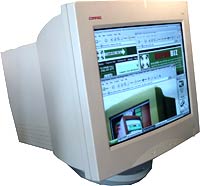|
|
| Help | |
| You are here: Rediff Home » India » Get Ahead » Money » Spend |
|
| |||||||||||||||||||||||
|
| |||||||||||||||||||||||
 one are the days where you are forced to stare at white blips on black screens.
one are the days where you are forced to stare at white blips on black screens.
As far as computer displays are concerned, a PC user can choose from a wide range of sleek and snazzy models.
Whether you are crunching figures at a front office job or crouched over a blood and gore video game in some deep recess of your room, there is the right kind of screen available to suit your needs.
Monitors are one segment where you are truly spoilt for choice.
Be it a 15-inch, 17-inch or 19-inch CRT monitor* or a sleeker range of LCD screens*, there is a wide range to fit your budget.
 Size and resolution
Size and resolution
There are two aspects you must consider when selecting a monitor: physical size and resolution.
Screen size is the diagonal screen measurement, usually in inches. For instance, a computer monitor display might be 14 inches wide and 11 inches tall. This same screen has a diagonal measurement of 19 inches, which is the screen size.
Monitors also have an aspect ratio.
This is the ratio between the horizontal dimension and the vertical dimension (horizontal dimension divided by vertical dimension). Common monitor aspect ratios are 4:3 (1.3333) and 5:4 (1.25).
A 4:3 aspect ratio means the picture is 4 units wide for every three units of height.
Wide screen monitors are easier on the eye (and much more expensive).
The higher the resolution, the greater the ability to render more detail. If you work with graphics or enjoy graphic-intensive games, you will need a monitor with higher resolution.
With most currently available models being flat screened, the difference is in the size and picture quality. A resolution of 1024 x 768 is a good one for most users.
CRT monitors
If you've decided to get a new CRT, make sure it has a sufficiently high refresh rate. This refers to how often the screen is redrawn per second. With low refresh rates you can get screen flicker and eyestrain.
Aim for a rate of 75 Hz for a monitor up to 17 inches in size and 85 Hz for any larger monitor.
Another consideration for CRTs is dot pitch. The smaller the dot pitch, the sharper the image. Opt for a dot pitch of 0.26 mm or smaller.
CRTs function very well at multiple resolutions, can display detailed graphics and can be viewed comfortably from wider angles.
LCD screens
One of the primary disadvantages of LCDs when compared to CRTs is their limited viewing angle. When viewing a LCD straight on, it looks great. But the screen will appear washed-out if you move your head over to the side and look at it from a wider angle.
Also, LCDs are optimised to perform at a single resolution. Low-end LCDs have viewing angles of only 100 degrees, which won't give everyone crowded round your desk a clear view.
For a standard 15-inch LCD, try to get a 140 degree viewing angle. Increase that by 20-40 degrees when shopping for an 18-inch LCD.
The brightness of LCD monitors is an important factor. LCD monitors have several backlights that provide illumination. The backlights in a LCD are good for 10,000 to 50,000 hours of operation. Ensure that the backlights come with at least a one-year warranty.
Making a choice
LCD screens generally cause lesser strain to eyes than CRT monitors.
CRTs have better graphics, but they tend to occupy five times as much space.
If you are a gaming freak, then a CRT is a better option as it is best for any graphic interface.
If you want the sleek look, an LCD is meant for you. It is widely used in banks and treasury and trading rooms.
The price
CRTs are nearly half the price of LCD screens.
Samsung is one of your best bets for desktop screens, in terms of reliability and service.
The price would be around:
CRT Samsung 17 inch SyncMaster 793s: Rs 6,700
CRT Samsung 15 inch: Rs 4,600
CRT IBM 17 inch: Rs 7,500
IBM (Lenovo), HP and Philips are the competitive brands, priced slightly higher than Samsung.
If you want an LCD screen, be prepared to almost double the price.
So don't let your machine's display be an incidental purchase. Put some thought into it. After all, if you've put down the money for that hot new PC game, you might as well put in some investment to view it better.
# The rates mentioned are Mumbai-based and are an approximation. Give the above figures a 10% to 15% band.
*CRT stands for Cathode Ray Tube and is a common type of computer display hardware. The other display technology being used more and more often in television sets is LCD, an abbreviated form of Liquid Crystal Displays.
Note: The recommendations and suggestions are purely at the author's discretion.
|
|
| © 2008 Rediff.com India Limited. All Rights Reserved. Disclaimer | Feedback |